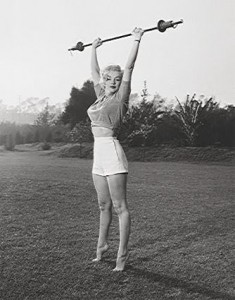“They” say what?
You may have heard of a new study that was circulating various news sources last week. (Thanks Charlotte for the tip off on Twitter.) The gist of the study was that women need an hour of moderate intensity activity 7 days a week to maintain a “normal” weight.
So what does this mean for women who really don’t have 60 minutes every day of the week to exercise? Or what about women like me who don’t want to devote 60 minutes every day to exercise but still want to feel good in a bikini be healthy? Is there another way?
Thankfully the answer is yes.
Metabolic resistance training.
Metabolic resistance training is perfect for those of us who don’t have or want to spend 60 minutes 7 days a week working out. In fact, it would be unsafe to do metabolic circuit training 7 days a week because when I push my body to its limit it needs rest to avoid injury from overtraining. Whew. Okay great. But what is metabolic resistance training? Metabolic resistance training is basically cardio and strength training combined. Unlike the traditional lift, rest, lift (same exercise as before), and repeat, different strength training exercises of varying intensities are done in circuits of varying lengths with little to no rest in between exercises.
Metabolic resistance training can be done with virtually any device that provides resistance including dumbbells, barbells, kettlebells, bands, and your body. Although I’m not so sure I like thinking of my body as a “device”. Generally speaking, metabolic circuits are full body workouts typically made up of compound moves with short rest periods. It’s similar to HIIT cardio but only with resistance.
Not only do you get an awesome workout in a short time but interval training with high intensity burns more calories than moderate intensity training after you workout due to the EPOC (Elevated post oxygen consumption) response. EPOC basically means that the more intense you workout the longer it takes your body to return to resting levels of energy expenditure. In other words, the more intense you workout the more calories you burn after your workout. A slow and steady workout, i.e. moderate intensity, will result in a shorter EPOC response = less calories burned afterwards. A hard and intense workout will result in a longer EPOC response = more calories burned afterwards.
So if last week’s news sounded like bad news to you, check out a headline from last week, Some pain All gain: Another argument for high intensity workouts. Or last month, Interval Training Can Cut Exercise Hours Sharply.
An example of a metabolic resistance type workout
A. Pull Ups (assisted): 10-15
B. Steps Ups: 10-15 each leg
C. Military Press: 10-15
Perform A-C back to back with little to no rest. Rest 2-3 minutes and repeat for a total of 3x through.
A. Squats: 10- 15
B. Push Ups: 10-15
C. Swings: 15-20
Perform A-C back to back with little to no rest. Rest 2-3 minutes and repeat for a total of 3x through.
As you grow in strength and endurance you can vary loads, reps, time (complete circuits faster), and rest making the workouts (in my opinion) more fun. The possibilites to challenge yourself are endless as opposed to steady state moderate intensity cardio where the only way to challenge yourself is to go longer or faster. However, if I keep increasing speed I will eventually end up in the same anaerobic zone as interval training with high intensity so why not just start there.
Is this only way to train? Absolutely not? I say find what you like because plan you will actually do is the BEST plan for you. Metabolic circuits or interval training is just what I am using right now for this busy time in my life because.. an hour? No thanks. I’d rather just get it over with and get on with…life or laundry. Or not.
Today is the last day to enter my first giveaway for the Oxygen Body Plan Kit.
Hugs and High Fives,
Jenn
If you enjoyed this this post please Subscribe to the RSS Feed.
Sign up for up to have posts emailed to your inbox.
Pin It



 This is my (almost) sane quest for insane health. Let's
This is my (almost) sane quest for insane health. Let's 

I love training that way to push myself in the gym. I usually do something similar to what you posted with a few supersets per workout to keep my heart rate pumping. I can’t wait to go back to that style of workouts since right now I have to limit my intensity. It sure is fun to bust butt in the gym!
Great post. I’m starting to incorporate more of these types of work outs and have definitely seen results.
Great post! After I read about the study, I actually thought that you could shorten the exercise time if you worked out harder. For me what works best is mixing things up. And I really need to add some shorter, intense workouts back into my routine…
I did metabolic resistance training for about a year and lost a TON of body fat. Too much in fact. Overtrain much, who me?
I’m glad you blogged about this. It bothers me that this message from the ‘powers that be’ will just serve to make people throw their hands up in the air and say “forget it!”. But you are very right about the Metabolic resistance training. I do this all the time and have done for a long time. I get bored just doing one type or another of exercise so I’m usually bopping back and forth.
And thanks to your Kettlebell tutoring, I’m falling in love with those and will be increasing the amount I do this sort of training.
Thanks Jenn! Another great post.
D
I agree that working out that much wouldn’t give your body time to rest and repair itself. I run on average five days a week – track practice at school Monday-Friday (sometimes we get a day off) and sometimes Saturday.
I’ve heard that full-body weightlifting (e.g. resistance training?) is more beneficial then what you described, the traditional lift, rest, lift, rest, working solitary muscles. (This is in regards to running, but I think it applies.)
Great information, Jenn. My trainer has me do this kind of circuit frequently, and I am starting to do it when I work out by myself–YAY!
How am I supposed to maintain my normal weight if I can’t hire a nanny to watch my kids??!
I’m all about more bang for your buck. Kettle bells anyone?
Good stuff Jenn.
Super interesting. I am in the market for a new matienance plan that doesn’t zap all of my time, so I’m definitely going to look into this more.
Interesting post and i had no seen that study, then again if it doesnt have to do with food blogs, nut butters and oat bran and how to be a raw vegan LOL i dont know much. including the state of the country. that’s a good thing though
anyway glad u liked my post tonite and also that i am willing to open up my blog to hot topics. well, it’s always a sweaty palm moment b4 i hit publish on those posts but it’s worth it.
your wt gain and lent and carbs and no meat. everyone’s body is different b/c i am plant based and dont gain weight on plants and lack of meat but hey, we’re all diff!
Loving this post!! I saw that article last week about working out 7 days a week for 60 minutes and my head spinned, lol!!! I love the metabolic resistance training plan, I think its great and thanks for sharing the two workout plans for it!! I am going to try these, I need more strength training in my life too!!!
Oh you never tried kranking either, yeah I dont know if I ever will, maybe my gym will get that machine one day!!
Love you!!!!
HEY i do that without even knowing it. nice to know there is a proper term great info. and who the hell could ever work out 7 days a week for an hour a day? that is some shiiii.
great info. and who the hell could ever work out 7 days a week for an hour a day? that is some shiiii.
I love that you wrote this!! That was my thought when I read that research too – when they say “60 minutes” they’re probably thinking of people who walk on the tready while catching up on Real Housewives. Not me. I had akiller workout today that would def. be considered metabolic. Short-n-hard!
Love that pic of Marilyn! Total believer in metabolic workouts. I do like a mellow 60 minute brisk walk or hike now and again but shorter, harder, more-varied workouts always give me the best results!
It¡¦s really a great and helpful piece of info. I¡¦m satisfied that you simply shared this useful information with us. Please keep us informed like this. Thank you for sharing.
That’s really thninikg of the highest order